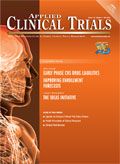Regulators, Researchers Seek to Streamline Cancer Trials
Applied Clinical Trials
There is great optimism that new genomic discoveries and technical advances will reduce the cost and time of moving important new therapies for cancer and other critical diseases from laboratory to patients.
There is great optimism that new genomic discoveries and technical advances will reduce the cost and time of moving important new therapies for cancer and other critical diseases from laboratory to patients. FDA officials are enthusiastic about a broader range of "expedited approval" mechanisms and new trial designs and methods that will support faster, smaller trials for new drugs that show signs early of effectiveness.
These developments were reflected in presentations about new biomarkers and breakthrough designations for cancer treatments at the April annual meeting of the American Association for Cancer Research in Washington, D.C. Some 18,000 scientists, clinicians, and government officials explored how studies can be targeted to the people most likely to benefit, addressing the perennial challenge of enrolling sufficient patients in clinical trials. Visible alarm about declining public and private resources to support biomedical research reinforced the importance of identifying new approaches that can reduce the cost of developing critical treatments.
The potential for biomarkers to accelerate drug development was apparent in several discussions about using "pathological complete response" (pCR) as a clinical trial endpoint for accelerated approval of new breast cancer treatments. FDA is expected to issue final guidance this year on design of trials utilizing pCR, as opposed to overall survival, as a prime endpoint in shorter, smaller studies to support registration. Trials using pCR to test neoadjuvant therapy for treatment of early stage breast cancer may facilitate research on drugs in healthier patients—instead of the traditional approach of giving experimental treatments first to patients with advanced disease who have resisted other treatments, with survival over time as the main endpoint. More needs to be learned, though, about whether pCR gains ultimately translate into long-term patient improvement; how pCR can be used in proof-of-principal studies to help shape larger, definitive trials; and whether it may be an effective marker for other cancers.
FDA officials also pointed to evidence that the new "breakthrough" drug designation will accelerate development of promising treatments. This program, which was established by the FDA Safety and Innovation Act of 2012, was described as "a dramatic success" by Rachel Sherman, Director of the Office of Medical Policy in the Center for Drug Evaluation and Research (CDER). In less than a year, the agency has received 36 requests for breakthrough designations, including 20 for oncology drugs. The agency has granted the designation to 10 products, many showing signs of being "real game changers," said Sherman, while about 12 have been denied.
The breakthrough designation is intended for drugs and biologics that treat a serious or life-threatening disease and present preliminary clinical evidence suggesting that it provides "substantial improvement" over existing therapies. Sponsors of such products are eligible for increased consultation with FDA and often will also qualify for accelerated approval and priority review by the agency to speed the approval process.
The breakthrough approach represents a "huge mindset change" for FDA, commented Richard Pazdur, Director of CDER's Office of Hematology and Oncology Products (OHOP), at another AAMC session. Pazdur emphasized the importance of a more iterative process between FDA and sponsors, with consults not limited to set landmark meetings.
While some of the first breakthrough designations involved new indications for existing therapies, Sherman noted that FDA now is receiving more requests at earlier stages of development. That enables CDER staff to provide input on clinical trial design, appropriate patient population, and overall development plan. In some cases, a single-arm trial may be appropriate, she observed. Sponsors will get more help from FDA draft guidance due this year, which sponsors hope will clarify terms such as "significant improvement over existing therapies," "available therapy," and "unmet need."
The best way to speed up approvals is for FDA to receive applications for "drugs that really work," said Pazdur. He observed that he has seen much better drugs submitted to the agency in the last five years, some so effective that they were approved without review by FDA's Oncologic Drug Advisory Commission (ODAC). That panel still will examine applications for drugs with questionable risk-benefit, statistical safety hazards, or novel delivery system and formulation. FDA also will ask its advisors to advise on controversial scientific issues, such as use of trial enrichment, target populations, and accelerated approvals. But the agency appears more willing to skip ODAC review when there's strong evidence for approval and a desire to move the product to market without delay.

Improving Relationships and Diversifying the Site Selection Process
April 17th 2025In this episode of the Applied Clinical Trials Podcast, Liz Beatty, co-founder and chief strategy officer, Inato, discusses a number of topics around site engagement including community-based sites, the role of technology in improving site/sponsor relationships, how increased operational costs are impacting the industry, and more.
Behind the Buzz: Why Clinical Research Leaders Flock to SCOPE Summit
February 7th 2025In this episode, we meet with Micah Lieberman, Executive Conference Director for SCOPE Summit (Summit for Clinical Ops Executives) at Cambridge Innovation Institute. We will dive deep into the critical role of collaboration within the clinical research ecosystem. How do we bring together diverse stakeholders—sponsors, CROs, clinical trial tech innovators, suppliers, patients, sites, advocacy organizations, investors, and non-profits—to share best practices in trial design, program planning, innovation, and clinical operations? We’ll explore why it’s vital for thought leaders to step beyond their own organizations and learn from others, exchanging ideas that drive advancements in clinical research. Additionally, we’ll discuss the pivotal role of scientific conferences like SCOPE Summit in fostering these essential connections and collaborations, helping shape the future of clinical trials. Join us as we uncover how collective wisdom and cross-industry partnerships are transforming the landscape of clinical research.